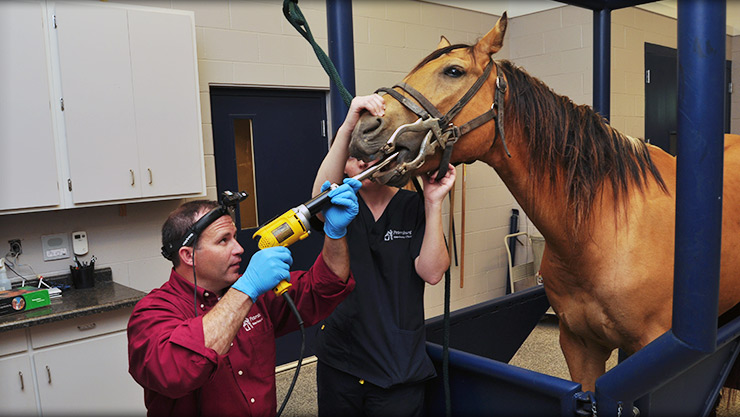Equine Dental Care – Horse Dental Care
Equine Dental Care & Horse Dental Care 101
Equine dental care is more than just floating
by Drs. Dean Scoggins, Jack Easley, W. Leon Scrutchfield, with Rahel Klapheke
Contact us for a no obligation insurance quote today!

The adult male horse has up to 44 permanent teeth, and a mare may have between 36-40 permanent teeth. Like humans, horses get two sets of teeth in their lifetime. The baby teeth, also known as deciduous teeth, are temporary. By age five, most horses will have their full set of permanent teeth.
Why so many? Evolution has designed the horse’s skull to accommodate greater quantities of high-fiber forage foods. The horse’s Eocene ancestor stood a little over two feet tall. Modern equus are now almost triple that height and require 27 times more food! An amazing grinding system of the horse’s teeth accommodates such an increase in food intake and processing.
Elongation of the head and neck allowed for continual pastural grazing; increasing the height and complexity of the tooth shape. The forward teeth, known as incisors, function to shear off forage. The cheek teeth, including the molars and premolars with their wide, flat, grooved surfaces, easily grind the feed to mash before it is swallowed.
Equine Dental Care – Horse Dental Care
Straight from the Horse’s Mouth
Equine dental care is more than just floating
When you schedule an appointment for yourself at the dentist’s office, you usually mark off a whole afternoon on your calendar. You have x-rays, get a thorough cleaning of each and every tooth, maybe get a tooth or two filled — and you almost always receive a lecture on how you need to floss more. Though it seems tedious, you know routine check-ups and diagnostic examinations contribute to the health of your teeth.
Your horse is no different. His teeth deserve practically the same care you give your own teeth.
Wait a minute — an equine root canal? Ponies with cavities? Not exactly; but your horse probably needs more than just the “float” you gave him five years ago.
A ton of teeth
Watch out tooth fairy! The adult male horse has up to 44 permanent teeth, and a mare may have between 36-40 permanent teeth. Like humans, horses get two sets of teeth in their lifetime. The baby teeth, also known as deciduous teeth, are temporary. By age five, most horses will have their full set of permanent teeth.
Why so many? Evolution has designed the horse’s skull to accommodate greater quantities of high-fiber forage foods. The horse’s Eocene ancestor stood a little over two feet tall. Modern equus are now almost triple that height and require 27 times more food! An amazing grinding system of the horse’s teeth accommodates such an increase in food intake and processing.
Elongation of the head and neck allowed for continual pastural grazing; increasing the height and complexity of the tooth shape. The forward teeth, known as incisors, function to shear off forage. The cheek teeth, including the molars and premolars with their wide, flat, grooved surfaces, easily grind the feed to mash before it is swallowed.
Biting the basics
To help appreciate the horse’s distinct eating process, let’s follow the path of the food particle.
First, the food touches the lips. Sensitive upper and lower lips are the integral structures for feed apprehension. During grazing, the lips are drawn back to allow the incisor (front central teeth) to sever the grass at the base.
Once the food enters the mouth, the horse begins mastication, or chewing, of the food by grinding it. This occurs by moving the mandible, or jaw, in a side-to side chewing movement; not up and down.
Chewing takes place where the molars are aligned in the skull, also known as the “molar arcade.” After several minutes of chewing, the food softens and is suitable for swallowing.
Picky, picky
Horses are selective eaters; they prefer grasses and legumes but a wide variety of shrubs, herb, woody plants and even roots may be selected. They tend to avoid eating grass in areas polluted with manure or horse urine.
The horse is a continuous grazer; that is, both confined horses in a stall and free-ranging animals usually eat 10-12 hours daily for 30-180 minute intervals if hay or pasture is available.
However, full confinement to a stall does affect eating behavior. Confined horses fed concentrate or pelleted feed eat more rapidly and spend the remaining time in boredom (i.e. standing, lying down, searching for food, chewing wood, etc.). Horses confined and not allowed access to pasture don’t use incisor teeth for shearing and this may lead to incisor overgrowth.
This is where your equine veterinarian comes in. Many arbitrary practices such as training techniques and full boarding change natural functions in the horse’s mouth. Dental problems can continually worsen unbeknownst to the owner or trainer. The horse may begin to resist the bit, not respond to common training techniques or even lose weight and the trainer may never consider that it may be a dental problem. From floating to filling, your practitioner can help you develop a dental hygiene program for your horse to help put “power steering” in your horse’s mouth.
Floating
Unfortunately, cheek teeth tend to develop sharp enamel points even under normal grazing conditions. Because the horse’s lower jaw is narrower than its upper jaw, and due to the grinding motion during chewing, sharp points tend to form along the edges. Points form on the cheek side of the upper jaw and the tongue side of the lower jaw.
Floating is the “rasping,” or filing of points on the teeth to prevent them from cutting the cheek or tongue. Floating may involve leveling of the molar arcades or rounding the surface of the second premolar to resemble the end of a thumb. The goal of floating is to maintain the symmetry and balance of the arcade and to allow free chewing motion.
The techniques used to float teeth vary between practitioners. Some veterinarians will sedate the horse and use a full-mouth speculum to allow greater thoroughness in the examination and more precision in performing corrective procedures.
But floating teeth is just one of many procedures that may be available from your veterinarian. Many other dental problems can develop and go undetected until severe pain becomes obvious.
Recap on caps
Deciduous (baby) teeth all should be replaced by the age of five years. Sometimes, however, these teeth are not shed and cause a “retained cap.” This condition can cause inadequate chewing, anorexia (loss of appetite) and poor performance.
Your veterinarian can extract the deciduous premolar or incisor once the boundary between the deciduous and permanent tooth is visible. If the baby tooth is extracted too early, though, the permanent tooth can be damaged.
Wolf teeth
Wolf teeth are very small teeth located in front of the second premolar and do not have long roots that set them firmly in the jaw bone. Lower wolf teeth are rare; but are sometimes found in lines of Standardbreds. A horse may have no or up to four wolf teeth.
Though not all wolf teeth are troublesome, veterinarians routinely remove them to prevent pain or interference from a bit. In addition, adequate shaping of the second premolar during floating cannot be done with wolf teeth present.
Don’t get hooked Normally, contact with the opposing tooth keeps biting surfaces equal. When cheek teeth are out of alignment, hooks can form. Hooks on the upper cheek teeth can interfere with bitting. Hooks on the lower cheek teeth can force the horse to chew up and down; causing stress on the jaw muscle.
Your equine veterinarian can remove these small hooks to stop unnecessary pain.
Canines
As the name suggests, canine teeth are sharp, tall teeth used for tearing food. Canines are primarly found in the male horse and can become too tall and sharp; increasing the risk of laceration to other horses when playing, chance of injury by catching on fixed objects, and difficulty in inserting and removing the bit. A veterinarian can shorten tall and rasp sharp canine teeth to prevent these occurrences.
More than just a toothache
Just like you, your horse can have many other problems with his dental hygiene. Common ailments horses suffer include loose and/or broken teeth, excessively worn teeth, infected teeth and gums and even gum disease.
Identify problems
It is important to catch dental problems early. Waiting too long may increase the treatment needed or may even make remedy impossible.
If a horse starts behaving abnormally, dental problems should be considered as a potential cause. Horses with dental problems may show obvious signs, such as pain or irritation of the mouth. Other indications of dental problems include
- loss of feed from mouth while eating
- difficulty chewing or excess salivation
- loss of body condition
- large, undigested food particles in manure
- head tilting or tossing, bit chewing, tongue lolling, fighting the bit or resisting the bridle
- bucking or failing to stop or turn
- foul odor from mouth or nostrils
- traces of blood in mouth
- nasal discharge or swelling of the face
Other horses may show no noticeable signs because they simply adapt to their discomfort. For this reason, have your veterinarian thoroughly examine and float your horse’s teeth at least once a year. This dental exam provides the opportunity to perform routine preventative dental maintenance and avoid having relatively minor problems become serious in the future. The end result is a healthier, more comfortable horse.
Dr. Dean Scoggins is a professor of extension at the University of Illinois. He is an active member of the American Association of Equine Practitioners.
Dr. Jack Easley is a private practitioner is Shelbyville, Ky. He has 20 years of special interest in equine dentistry and oral disease.
Dr. W. Leon Scrutchfield is a professor and chief of field services at Texas A & M’s College of Veterinary Medicine. He has given numerous presentations on equine dentistry to veterinary groups and horse owners and trainers.
Rahel Klapheke is with the American Association of Equine Practitioners at 4075 Iron Works Pike, Lexington, Ky, 40511, (606) 233-0147.
The Power of Prevention:
Most Equine Dental Care or equine dentistry involves prevention. If your horse’s teeth are regularly cared for, the maintenance process will not be overwhelming and you should be able to avoid most dental or health complications. Depending on your horse’s diet, hardness of teeth and jaw alignment, he may need floating on an annual basis or perhaps he could last years between floating. By keeping an eye on your horse’s teeth, you can determine how quickly your horse’s dental surfaces are changing and get them cared for before complications arise.
Part of prevention is knowing whom to call when you need equine dental care. Some veterinary teaching hospitals do not teach tooth floating and your particular veterinarian may or may not be schooled and experienced in this process or in the art of realigning a maloccluded mouth. If (s)he is not, you may need to locate an equine dentist in your area.


